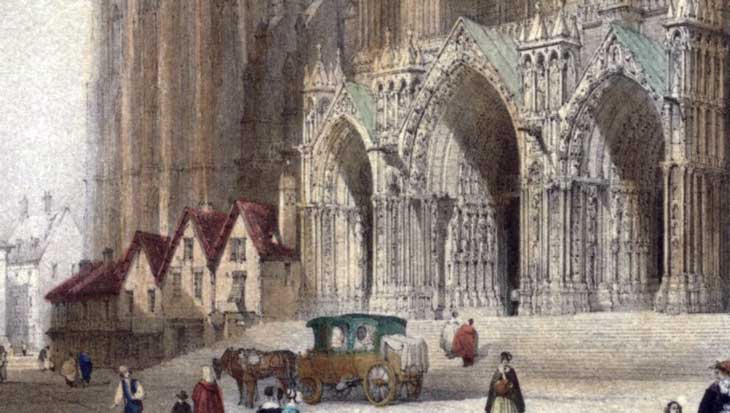In 1824, Antoine Pierre Marie Gilbert attacked the last medieval houses built at the foot of the nave. It was already a time when old buildings were being cleared.
Considered on a par with works of art: on display in museums – on pedestals. This text reveals the gradual “objectification” of the cathedral. In the 19th century, every effort was made to enhance the “monument” as an object of local pride, regardless of the habits that prevailed at the time of its construction.
This movement eventually led to the destruction of the buildings occupying the current western forecourt.
« At the bottom of the buttress pillars, against the side walls of the nave, on the south and north sides, are miserable shacks, whose hideous appearance detracts from the exterior of this beautiful edifice. We would like to see these shacks removed as soon as possible; their demolition, long desired, has only been delayed by motives of little interest or carelessness. Finally, we would like to express our wish that this beautiful monument be isolated from anything that would deprive it of the admiration of connoisseurs ».

1856 – The clearing of the surroundings of the cathedral.
An unpublished text, which is not without its interesting debates. In the middle of the 19th century, the Chartres town council justified the destruction of the buildings adjoining the cathedral in the following terms: the evolution of ancien régime social structures, i.e. the disappearance of the Notre-Dame chapter; and the reconfiguration of its territorial holdings, the Notre-Dame cloister.
What does the phrase “The appreciation of the magnificence of great buildings is very different from what it should have been” imply? The author is undoubtedly referring to the monumentalization of heritage, without conceptualizing it in such an abstract way. The 19th century is characterized as the era of building at the ends of perspectives and above steps: statues of great men, commemorative steles and fine arts museums. It wasn’t until the twentieth century that the role of the context came to the fore: a place embedded in an urban fabric, testifying to its pre-eminent religious function at the heart of the city.
Municipal Archives of Chartres.
City Council Minutes. Session of November 14, 1856.
Project to create a square and a grand street in front of the Cathedral’s Royal Gate. Extract from the mayor’s statement.
« Leveling and macadamization works have recently replaced uneven paving in the Notre-Dame cloister… This beneficial improvement for traffic also highlights… the need to clear the surroundings of the Cathedral in front of the main entrance, so as to give residents and foreigners alike the opportunity to admire the beauty of the monument for which the city is famous, to study the details of its composition and architecture, and to allow this edifice to develop its full splendor for the eyes of the beholder. Therefore, I propose that we decide to establish a square and a street of suitable width in front of the royal gate, and that this street be extended as far as Rue Ste Même…
Looking back, we can see how the surroundings of religious monuments, isolated at the time of their construction, were successively squeezed together by housing… The need to remove most of the buildings that seem to compress the Cathedral monument at its base, like a belt, is due to the exercise of the Chapter’s right of ownership over the centuries. It is easy to understand that the obligation for the clergy to attend religious services… led them in the past to enclose the vast space in front of the Church with buildings occupied by religious individuals. This state of affairs has been destroyed by time and circumstances; ownership of the Cloister has passed into hands other than those of the Chapter, and appreciation of the magnificence of the great edifices is very different from what it once was. It is in order to embark on this new path, which is also the expression of a public sentiment that is quite widespread among the inhabitants of Chartres, that I have considered it opportune to ask you to take a decision in favor of the project I am submitting to you, which will provide the city with the embellishment it so desperately needs… ».